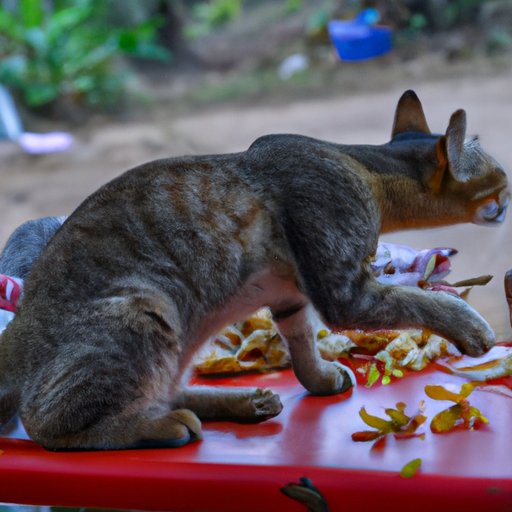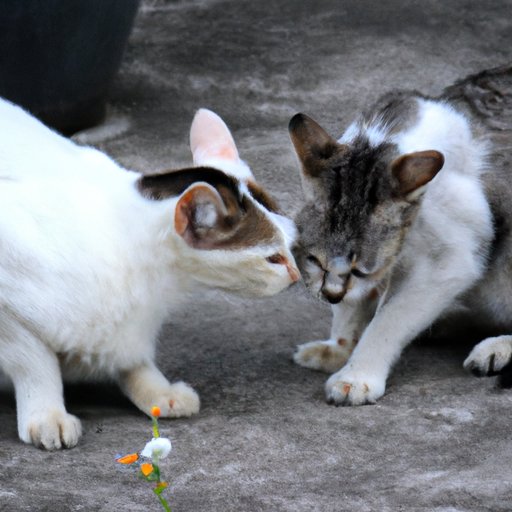
Introduction: Understanding a Common Behavior Among Cats
If you’re a cat owner, you’ve likely noticed your furry friend rubbing their face on just about anything within sight. Maybe it’s the furniture, walls, or even your own legs. While this behavior may seem odd and even annoying at times, there’s actually a lot more to it than meets the eye. In this article, we’ll explore why cats rub their faces on things, decoding this behavior from a feline perspective.
The Secret Language of Feline Communication: Decoding Why Cats Rub Their Faces on Everything
Cats are known for their keen sense of smell, using it as a primary way to communicate with both other cats and humans. One way they do this is through “bunting,” a behavior whereby they rub their faces against objects or surfaces. By doing so, they leave behind pheromones that can convey a range of messages, such as marking territory, signaling friendship, or even expressing sexual interest.
Examples of objects and surfaces that cats tend to rub their faces on include furniture, walls, doorways, and even other animals in the household. It’s important to note that this behavior is not limited to certain breeds or ages of cats, as it’s a natural and instinctual part of their communication repertoire.
The Nose Knows: Understanding Why Cats Rub Their Faces on Objects and Humans
So why do cats rub their faces on objects and humans? Ultimately, it comes down to the power of scent. For cats, smell is a critical tool for navigating their environment, identifying potential threats or prey, and establishing social bonds. When they rub their faces on objects or people, they’re depositing their own unique scent, which can signal a range of messages to other cats or humans in the area.
This behavior is particularly important for cats who live in multi-cat households, as it allows them to leave messages for one another and establish territory boundaries. It can also be a way for cats to bond with their humans, as they associate the scent of their owner with feelings of comfort and safety.
The Science Behind Feline Pheromones: Exploring Why Cats Rub Their Faces on Things
To truly understand the behavior of face-rubbing, it’s essential to delve into the world of feline pheromones. Pheromones are chemical signals that animals release into their environment, often for the purposes of communication or signaling mates. For cats, pheromones are produced by special glands located on their face, paws, and tail.
When a cat rubs their face on an object or surface, they’re leaving behind a mixture of pheromones that can convey important messages. For example, scent marks on furniture or walls could signal to other cats in the household that this particular area is off-limits, while rubbing against a human’s leg could signal a friendly greeting or a request for affection.
The Evolution of Feline Behavior: Uncovering Why Cats Rub Their Faces on Different Surfaces
While scientists are still investigating the exact origins of face-rubbing behavior, there are a few theories as to why it may have evolved in cats. One idea is that it’s a way for cats to create a communal scent, which can help strengthen social bonds within a group. Another theory is that it’s a way for cats to mark their territory and defend it against other cats or potential predators.
Interestingly, the surfaces that cats choose to rub their faces on can reveal a lot about their motivations and social standing. For example, dominant cats may prefer to rub their faces on higher surfaces, such as shelves or windowsills, while more submissive cats may stick to rubbing against lower surfaces, such as floors or furniture.
From Love to Territory: A Comprehensive Guide to Why Cats Rub Their Faces on Furniture, Walls, and Other Objects
There are different types of marking behaviors that cats exhibit, each serving a specific purpose in feline communication. For example, when a cat sprays urine on an object or surface, it’s a more aggressive form of scent marking that signals their territory and warns other cats to stay away. Rubbing their face on objects or surfaces, on the other hand, is typically a more friendly gesture that can signal affection or a desire to bond.
However, it’s important to note that every cat is unique and may exhibit different behaviors depending on their personality or living situation. Some cats may be more territorial and prone to aggressive marking behaviors, while others may be more social and eager to bond through face-rubbing.
The Psychology of Feline Affection: Revealing the Reasons Why Cats Rub Their Faces on Their Owners
Many cat owners can attest to the joy of having their cat rub their face on them, as it’s a clear sign of affection and attachment. From a psychological perspective, cats may choose to rub their faces on their owners as a way of forming a positive association between their scent and feelings of safety and comfort.
Owners can also reinforce this behavior by providing positive reinforcement, such as petting or giving treats when their cat rubs their face on them. This can help strengthen the bond between cat and owner, creating a deeper sense of trust and affection.
Conclusion: Understanding the Importance of Face-Rubbing Behavior in Cats
In conclusion, face-rubbing is a common and important behavior among cats, serving a range of purposes in feline communication and social bonding. By understanding the science behind pheromones and the psychology of scent-based communication, we can deepen our appreciation for the complex and fascinating world of our furry feline friends.
Ultimately, by embracing this behavior and responding positively to our cats’ attempts to bond with us, we can create a stronger and more rewarding relationship for both cat and owner.
